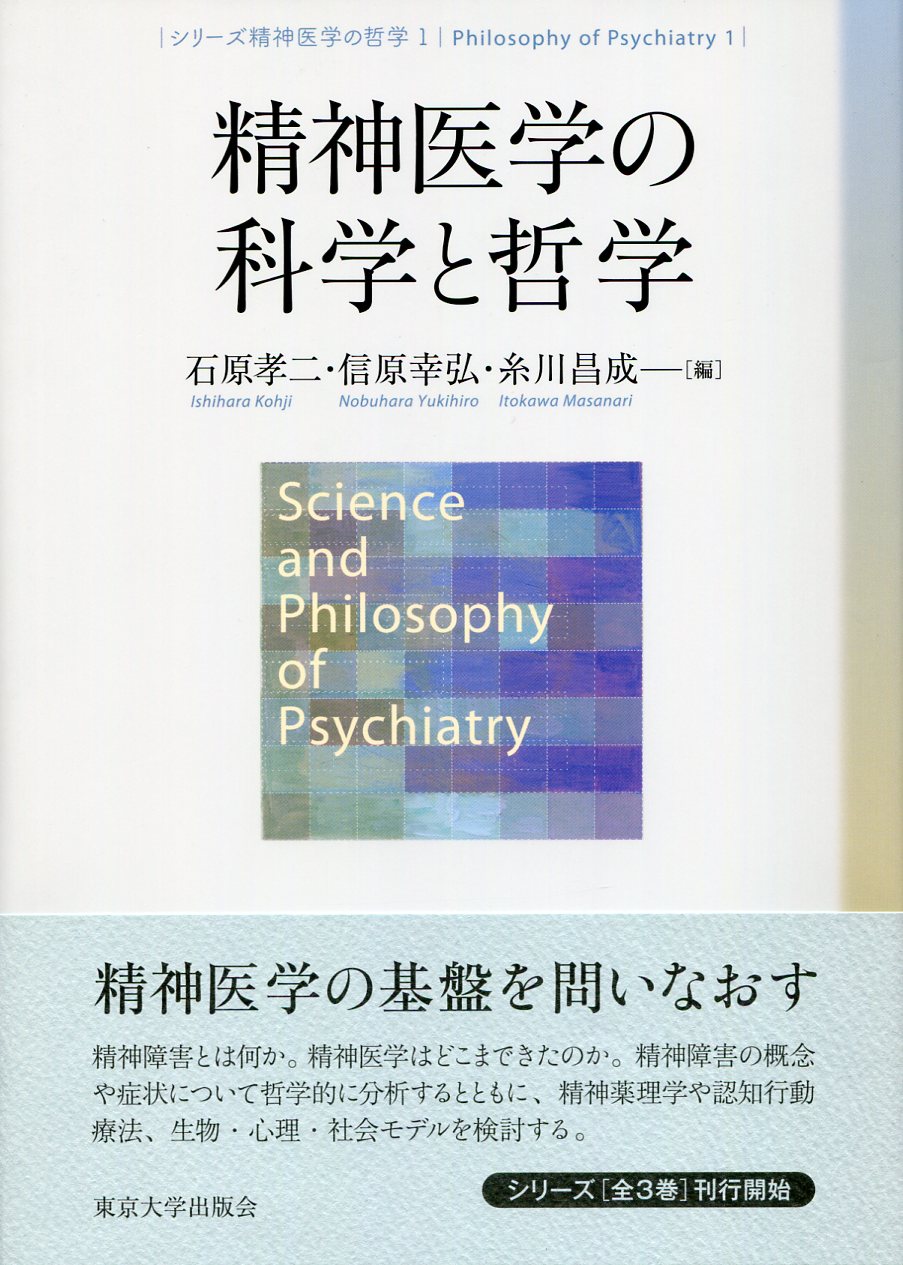
Title
Seishin-shogai o tetsugaku-suru: Bunrui kara Taiwa e (Philosophy of Mental Disorder: From Classification to Dialogue)
Size
332 pages, 127x188mm
Language
Japanese
Released
September 18, 2018
ISBN
978-4-13-010137-0
Published by
University of Tokyo Press
Book Info
See Book Availability at Library
Japanese Page
The purpose of this book is to "philosophize" mental disorder, that is, to examine the meaning of the concept of mental disorder. Mental disorder has been regarded as a firm medical concept in psychiatry since the latter half or 20th century, but its meaning has not been clear. This book attempts to trace the historical development of psychiatry and related fields of thought, as well as re-examine the practice of psychiatry from a philosophical perspective.
This book has three parts. The first part, "Insanity and the Philosophy of Psychiatry," discusses the relationship between insanity and philosophy and the peculiarities of psychiatry. The first chapter, "Insanity and Reason," focuses on the concept of "common sense," discussing philosophical approaches to madness, from the ancient Stoic School, to Cicero and Kant. The second chapter, "Modern Disease Concept and the Emergence of Psychiatry," examines the process of the emergence of psychiatry and the uniqueness of psychiatry by studying Sydenham's concept of disease and Kraepelin's concept of "disease process." The third chapter, “Biological Approach and Psychopathology,” discusses the historical implications of brain function localization theory and the discovery of psychotropic drugs, and critically examines Jaspers' psychopathology as well as phenomenological psychopathology.
The second part of the book, Concepts and Classification of Mental Disorders, deals with the classification of mental disorders. Psychiatry has always been concerned with the question of how to classify mental disorders. After World War II, the DSM (Diagnostic and Statistical Manual of Mental Disorders) issued by the American Psychiatric Association and the ICD (International Classification of Diseases) issued by the WHO had a great influence on the classification of mental disorders. In recent years, a project (RDoC) aiming to create a classification system independent from DSM and ICD has been promoted. The second part of the book deals with the modern history of attempts to classify mental disorders as well as philosophical debates over the relationship between mental disorders and "natural kinds," and Wakefield's attempt to view mental disorders as "harmful dysfunction." It also examines the impact of the homosexual debate on the concept of mental illness.
In Part III, "Community Psychiatric Care and Tojishas," we reconsider the "biological, psychological, and social models" and movements from tojishas, such as peer support, self-help, the Consumer / survivor movement. We discuss the "dialogical approaches" in community psychiatry and psychiatry since the latter half of 20th century. "Dialogical approaches" refers to the Trieste Model in Italy and the Open Dialogue Approach in Finland, which emphasize the agency of the tojishas instead of emphasizing diagnosis. This part also discusses "tojisha kenkyu " that began in Urakawa-cho, Hokkaido, discussing its impact on psychiatric services and its relationship with phenomenology.
The subtitle of this book, "From Classification to Dialogue," looks towards the future direction of psychiatry. Since its inception, psychiatry has strived for an objective diagnostic classification, but it is yet to succeed. Classification should not be a priority, and the significance of diagnostic classification in the dialogue process with tojishas should be questioned. Psychiatry and psychiatric care should shift to an emphasis on dialogue and the agency of tojishas. The subtitles of this book reflect these expectations of the author.
(Written by ISHIHARA Kohji, Professor, Graduate School of Arts and Sciences / 2020)
Table of Contents
Chapter 1: Madness and Reason
1 Madness and philosophy in ancient Greece and Rome
2 The concept of common sense
3 Madness and Otherness of reason
4 Lock and common sense
5 Kant's attempt to classify “head diseases”
6 Illusion of sense and deception of reason
7 Common sense and the acquisition of others' perspectives
8 Madness and subject with reason
Chapter 2: The Modern Concept of Disease and the Emergence of Psychiatry: Why Psychiatry Is Always "Undeveloped"
1 Sydenham's concept of disease
2 Denial of ontological concept of disease and organ-functionalism
3 Localists and organ-functionalism
4 Establishment of germ theory and the ontological concept of disease
5 The development of insanity classification systems after the late 18th century
6 The appearance of the word “psychiatry”
7 Specialization and hospitals: Is psychiatric specialization delayed?
8 Kraepelin's concept of disease
Chapter 3: Biological Approach and Psychopathology
1 Brain function localization theory
2 Response to brain function localization theory
4 Jaspers and Phenomenological Psychopathology: Understanding the Experience of People with Mental Disorders
4 Development and Limitations of Phenomenological Psychopathology
5 Pharmacotherapy and Psychopathology
Part II: Concepts and Classification of Mental Disorders
Chapter 4: The Genealogy of Dementia, Schizophrenia, and Autism: Why Schizophrenia and Autism Have Become Important Mental Disorders
1 Intellectual Disability and Dementia
2 Formation of the Concept of Schizophrenia
3 Schizophrenia and stigma
4 Genealogy of Autism
Chapter 5: DSM and ICD: Modern History of Attempts to Classify Mental Disorders
1 Appearance of “Mental and Behavioral Disorders” chapter in ICD-6
2 DSM-I and DSM-II
3 DSM-III and descriptive approach
4 A potentially Biological Medical Model and Neo-Kraepelinism
5 Spitzer's definition of a non-biological medical model and mental illness
6 DSM-5 and dimensional approach
7 End of DSM / ICD system (?) and RDoC project
Chapter 6: Philosophy of Mental Disorders: "Natural Species" and "Harmful Dysfunction" Model
1 Are mental disorders natural kinds?
2 Natural kinds and Boyd’s HPC kinds
3 Cooper's concept of natural kinds
4 Wakefield's "harmful dysfunction" model
5 Dysfunction model as a personalized model
Chapter 7: Homosexuality and the concept of mental disorder
1 Conditions of the definition of mental disorders
2 About homosexuality
Part III: Community Mental Health Care and Tojishas
Chapter 8: Community Mental Health and Dialogical Approaches
1 Rethinking bio-psycho-social models
2 Changes in the position of mental hospitals
3 Deinstitutionalization and transition to community mental health care
4 Trieste model (Italy)
5 Open Dialogue Approach
6 Open Dialogue Approach and Needs Adaptive Approach
7 Systems and research supporting open dialogue
Chapter 9: Activities by Tojishas (Parties)
1 Alleged Lunatics ’Friend Society
2 Peer support / self-help group
3 Consumer / survivor movement: liberation and care
4 The concept of “recovery”
Chapter 10: Impact of Tojisha Kenkyu
1 The concept of “tojishas”
2 The birth of Tojisha Kenkyu
3 The context of Tojisha Kenkyu
4 Tojisha Kenkyu and phenomenology
5 Anti-psychiatry and Tojisha Kenkyu
6 The development and Spread of Tojisha kenkyuy
7 The significance of Tojisha kenkyu
Final Chapter: Mental Disorders and the Future of Psychiatry
Related Info
Kagaku-tetsugaku (Philosophy of Science. Journal of the Philosophy of Scienece Society, Japan). Sep. 30, 2020)
Kyoyo-gakubu ho (Bulletin of the University of Tokyo, College of Arts and Sciences). Jan. 8, 2019
Rinsho Shinrigaku (Clinical Psychology) 19:3 (2019)
Kokoro to Shakai (Mind and Society) 176 (2019)
Introductory articles (Japanese):
Shukan Dokusho-jin. Dec. 21, 2019
Tosho Shinbun. Dec. 22, 2019
Bethelmonde 16 (2019)
Seishin Kango (Psychiatric Nursing) 22:5 (Sep. 2019)
Hop, Step, Down. Vol.161 (2018)
Seishin Kango (Psychiatric Nursing) 22:5 (Sep. 2019)



 Find a book
Find a book


 eBook
eBook

